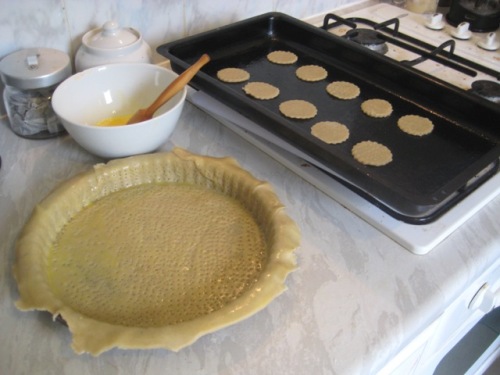Pre-baking and baking blind
 Monday, December 13, 2010 at 9:13PM
Monday, December 13, 2010 at 9:13PM An exert from Elizabeth Hodder’s The Book of Old Tarts

The other day Paula left this helpful comment on my shortcrust pastry post:
I noticed that you put egg on your pastry cases - so I followed suit but then had a hilarious time later trying to pick out my ceramic [baking] marbles which had got stuck to the pastry case! So my question is - does the egg make a difference?
I am impressed by Paula's attention to detail. I went through all my posts relating to shortcrust pastry looking for the instructions on egg wash and when I couldn't find them re-read her comment and realised that she had "noticed" (rather than read) that I use egg. How I wondered? Then I noticed; the photo.
As I said in my response to Paula's comment, I have been meaning to post this helpful exert from Elizabeth Hodder’s The Book of Old Tarts for ages, so thanks Paula for giving me the impetus.
In her introduction, Lizzie offers two methods for pre-baking, one using ceramic marbles or baking beans like those Paula refers to and the other which involves simply pricking the base all over with a fork. I use the latter because I think it is quicker, easier and just as effective. Even Lizzie who loves her Elizabeth David clay baking beans admits that it is more efficient.
Paula also asks whether the egg makes any difference. In answer to this question I replied that the egg is important for 'waterproofing' the case so it doesn't get soggy and that if I were using beans I'd probably put the egg wash on after and then put it back in for 5 mins. I was pleased to see when I revisited Lizzie’s book that this is exactly what she recommends.
Having lined your tart tin with pastry, and after a further rest in the fridge, the next step is critical for avoiding something that can spoil any tart – a soggy bottom. Most pastry cooks have their own ideas on how to avoid soggy bottoms, but there are two main ways:
BAKING ‘BLIND’ – I am addicted to my original 1960s Elizabeth David clay baking beans, and am a great believer in baking ‘blind’. Line the pastry case with non-stick baking paper or greaseproof paper and fill with baking beans. Place on a pre-heated baking sheet and bake in a pre-heated hot oven (200C/400F/Gas 6) for 15 minutes. Remove from the oven and lift the beans out with the paper. Prick the pastry base all over using a fork and brush with beaten egg before returning to the oven for a further 5-10 minutes, until it turns a light golden brown.
PRE-BAKING – prick the uncooked pastry shell thoroughly with a fork to release some of the trapped air, brush the base with beaten egg to provide a waterproof coating (you can also use a sweet glaze such as warm, sieved apricot jam) and then cook in a warm oven (180C/350C/Gas 4) for 25 minutes, preferably on a pre-heated baking sheet. This method works perfectly and it has the advantage of involving only one instead of two procedures. I miss my beans, but I am recommending using this second method in this book.
Hodder, E. (2001) The Book of Old Tarts. Headline: London.
 Vix |
Vix |  Post a Comment |
Post a Comment | 
Reader Comments